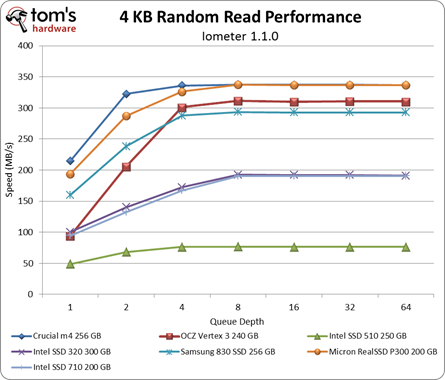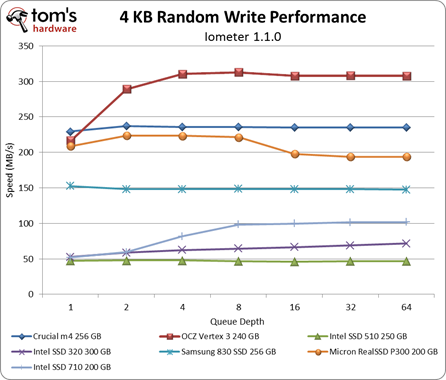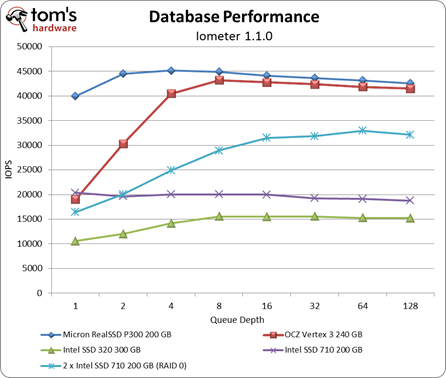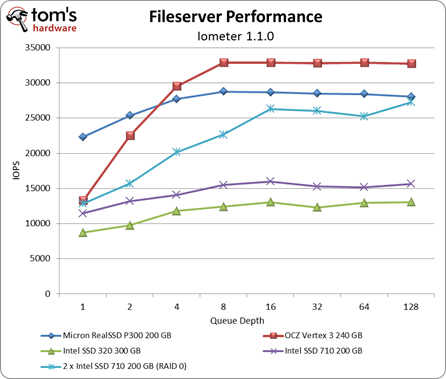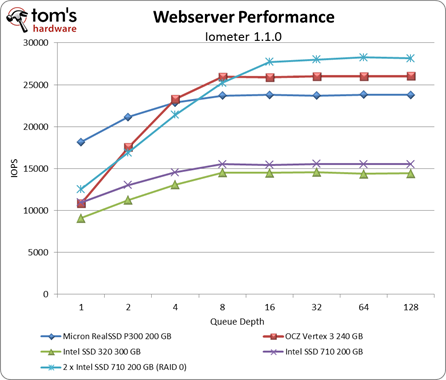Intel SSD 710 Tested: MLC NAND Flash Hits The Enterprise
Benchmark Results: Enterprise Performance
You'll see periods of low activity in any type of workload, even in enterprise applications. However, more so in data centers than desktop workstations it's safe to expect random access with a large number of outstanding I/O operations.
In random reads, the SSD 710 offers similar performance to the 320, even at higher queue depths.
Writes are another story, though. Once we move to a queue depth of four (effectively 16, since we're using four workers), the SSD 710 starts to pull ahead of the 320. But, at best, it's only able to achieve a 20-30% lead. Obviously, that's not enough to match the speed of SATA 6Gb/s SSDs, which makes sense since Intel's proprietary controller is a 3 Gb/s device.
Why does the SSD 710 appear to outperform the SSD 320 when its write spec is supposed to be less aggressive? In enterprise-class applications, the system always writes random data to the entire LBA space, since the SSD has a tendency to be empty (consider the drive used as a cache). As the LBA space increases, random write performance drops because the controller needs to perform more disk operations, such as garbage collection, to maintain health and performance. Conversely, consumer drives are at least partially filled with persistent data, which is why performance is measured in a fixed LBA space. However, we're testing relative performance, so the LBA test space is fixed to just 16 GB.
Subjected to a database workload, the SSD 710 offers better performance than its consumer-oriented counterpart, but speeds are still relatively (and understandably) poor compared to competing SATA 6Gb/s-based SSDs. When we stripe two 710s, performance improves, though not linearly. At best, performance in RAID 0 still falls short of SLC-based SSDs like the P300.
The file server profile employs a more read-heavy workload, which is why the 710 scales better in RAID. However, this is also an area where most SATA 6Gb/s SSDs really shine.
This is particularly evident at the extreme end, where the Vertex 3 hits ~33 000 IOPS. That's 5000 IOPS higher than two 710s in RAID. Though the Vertex 3 isn't directly comparable here, the Vertex 3 Pro would be, and it performs very similarly. That drive still has to prove itself in an enterprise environment, though. When we surveyed data centers for Investigation: Is Your SSD More Reliable Than A Hard Drive?, all of them were running Intel drives. Intel is unquestionably the incumbent in a competition that puts reliability on a higher pillar than raw speed.
Get Tom's Hardware's best news and in-depth reviews, straight to your inbox.
The Web server profile is similar to the previous file server workload. It's composed of 100% reads and gives more weight to smaller transfer sizes. As a result, we finally see a case where a pair of 710s in RAID 0 can surpass the SLC-based P300 and speedy Vertex 3. However, this only occurs at queue depths higher than 16. In a single-drive configuration, the SSD 710 only leads the 320 by a small margin.
Current page: Benchmark Results: Enterprise Performance
Prev Page Benchmark Results: 4 KB Random And 128 KB Sequential Performance Next Page Sequential Performance Versus Transfer Size-
whysobluepandabear TLDR; Although expensive, the drives offer greater amounts of data transfer, reliability and expected life - however, they cost a f'ing arm and a leg (even for a corporation).Reply
Expect these to be the standard when they've dropped to 1/3rd their current price. -
RazorBurn To some companies or institutions.. The data this devices hold far outweighs the prices of this storage devices..Reply -
nekromobo I think the writer missed the whole point on this article.Reply
What happens when you RAID5 or RAID1 the SSD's??
I don't think any enterprise would trust a single SSD without RAID. -
halcyon __-_-_-__with the reliability those have they will never ever find their way into any serverMy Vertex 3 has been very reliable and I'm quite satisfied with the performance. However, I've heard reports that some, just like with anything else, haven't been so lucky.Reply -
toms my babys daddy I thought ssd drives were unreliable because they can die at any moment and lose your data, and now I see that they're used for servers as well? are they doing daily backups of their data or have I been lied to? ;(Reply -
halcyon toms my babys daddyI thought ssd drives were unreliable because they can die at any moment and lose your data, and now I see that they're used for servers as well? are they doing daily backups of their data or have I been lied to? ;(SSDs are generally accepted to be more reliable than HDDs...at least that's what I've been lead to believe.Reply -
Onus halcyonSSDs are generally accepted to be more reliable than HDDs...at least that's what I've been lead to believe.Yes, but when they die, that's it; you're done. You can at least send a mechanical HDD to Ontrack (or a competing data recovery service) with a GOOD chance of getting most or all of your data back; when a SSD bricks, what can be done?Reply
-
CaedenV nekromoboI think the writer missed the whole point on this article.What happens when you RAID5 or RAID1 the SSD's??I don't think any enterprise would trust a single SSD without RAID.The assumption is that ALL servers will have raid. The point of this article is how often will you have to replace the drives in your raid? All of that down time, and manpower has a price. If the old Intel SSDs were about as reliable as a traditional HDD, then that means that these new ones will last ~30x what a traidional drive does, while providing that glorious 0ms seek time, and high IO output.Reply
Less replacement, less down time, less $/GB, and a similar performance is a big win in my book.
toms my babys daddyI thought ssd drives were unreliable because they can die at any moment and lose your data, and now I see that they're used for servers as well? are they doing daily backups of their data or have I been lied to? ;(SSDs (at least on the enterprise level) are roughly equivalent to their mechanical brothers in failure rate. True, when the drive is done then the data is gone, but real data centers all use RAID, and backups for redundancy. Some go so far as to have all data being mirrored at 2 locations in real time, which is an extreme measure, but worth it when your data is so important.
Besides, when a data center has to do a physical recovery of a HDD then they have already failed. The down time it takes to physically recover is unacceptable in many data centers. Though at least it is still an option.
